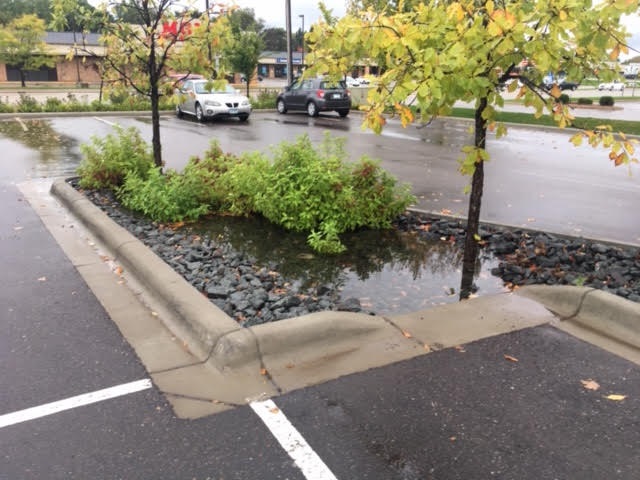Goodwill Development & Wetland Mitigation
Quick Facts:
The Goodwill store at Highway 96 and Centerville Road contains a variety of exceptional stormwater features that go above and beyond most commercial properties. A variety of stormwater features such as tree trenches, curb-cuts, and retention basins capture and treat an estimated 71,850.4 gallons (9,605 cubic feet, or ~1,796 bathtubs) of stormwater runoff in a 1.1” rain event.
Runoff volume, nutrient, and sediment reductions benefit Lambert Creek, which is the receiving waterbody.
Site plan takes in and accommodates for runoff coming from a neighboring property.
Year completed: 2017
Funding:
Effort was privately funded.
Reason for Project:
Before Goodwill, this site contained a degraded and heavily altered wetland. A neighboring property contained a large amount of impermeable surfaces that drained to the site’s wetland. The high velocity of this incoming stormwater had caused intense erosion and deep gullies. The history of the property was also troublesome for the wetland, as it had been modified and filled illegally under the Wetland Conservation Act (WCA).
The property was left unsold for several years due to the difficulty of both building on the site and accommodating for current standards for building on and around wetlands. Eventually, Goodwill purchased the property and underwent an intensive planning process with VLAWMO, the City of White Bear Lake, Ramsey County, Kimley Horn, and Driessen Group LLC.
Construction:
To develop this site on and around the existing wetland, the Goodwill building and parking lot had to plan to keep a significant amount of stormwater runoff on site, preventing it from draining off the property. Additionally, wetland banking credits were purchased at a 2:1 replacement ratio, for a total of 0.84605 ac. Construction took place from October 2016-April 2017.
There was 14,406 ft2 of onsite wetland mitigation to satisfy VLAWMO requirements. Applicant purchased 36,854 ft2 of wetland credit from a BWSR and COE approved wetland bank in watershed 20, service area 7. Property and neighboring property drainage is divided into 6 drainage areas with specific strategies, as seen in the diagram below.
Stormwater retention strategies on the property include:
- Underground sand filtration system beneath parking lot, outlet to on-site wetland: 1
- Tree trenches with curb-cuts to collect surface runoff: 4
- Stormwater pond/basins to collect runoff and settle out sediments: 2
- Outlet control structures to MNDOT (35E) ditch: 2, outlet control structures from front parking lot to Centerville Road stormdrain: 3
Results:
- For an annual average rainfall of 31.8” for the zip code the project is located in, an estimated 2,077,131 gallons (277,672 cubic feet, ~51,928 bathtubs) of stormwater runoff is captured and treated on-site annually.
- Compliance with current Wetland Conservation Act standards, exceeding requirements.














